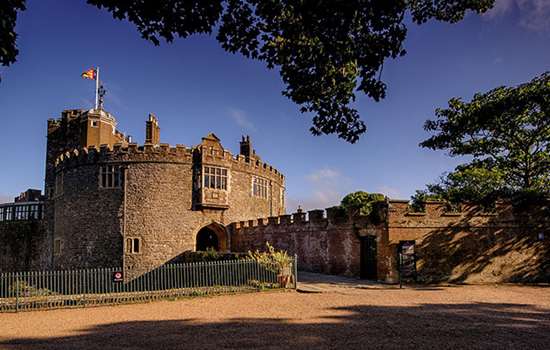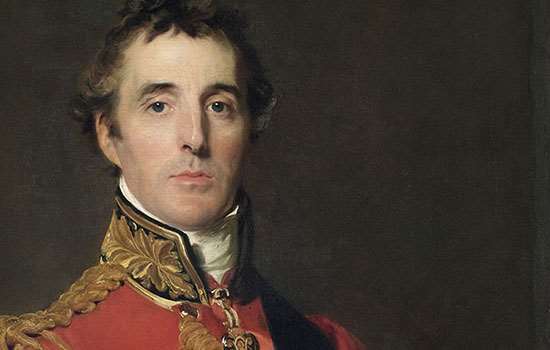Born into privilege
Lady Hester Lucy Stanhope was born in 1776, the first child of Charles, Earl Stanhope, and his wife, Lady Hester, née Pitt, who died when Hester was only four. She grew up at the family home, Chevening in Kent, and at 24 went to live with her grandmother, Lady Chatham, widow of the former Prime Minister William Pitt the Elder, in Somerset. Lady Hester, who enjoyed life as a young woman of privilege, was intelligent and confident, with a sharp wit and interests that extended far beyond typical genteel pursuits.
After the Peace of Amiens in 1802, when Britain and France were briefly at peace, Lady Hester travelled in Europe. Her grandmother died while Hester was abroad and, on returning to England in July 1803, Hester had no wish to live at Chevening with her increasingly eccentric father.
Instead, she joined her uncle, William Pitt the Younger, who had been Prime Minister from 1783 until 1801. He was then living at Walmer Castle in Kent, which came with his role as Lord Warden of the Cinque Ports.
The Prime Minister’s hostess
For the next two and a half years, Lady Hester became her unmarried uncle’s social hostess, enjoying a hectic, heady life, the more so after Pitt became Prime Minister again in May 1804. She was often with him on business, staying at Downing Street and his houses in Putney (south London) and Walmer Castle, mixing with the high and mighty of contemporary society, gaining political insight, and exercising power and influence.
In the winter of 1803–4, when Britain was again at war with France, Pitt was often at Walmer. From there he rode out extensively in the south-east, reviewing troops for the volunteer army he was helping to raise against an expected invasion by Napoleon Bonaparte. Lady Hester often accompanied him, and entertained guests at Walmer. His life became hers, as she confessed in a letter in January 1804:
I cannot pretend to tell you what will become of me this winter, as it will all depend upon Mr Pitt’s plans, which you know circumstances must govern.
Lady Hester adored being at the centre of society, mixing with politicians and with military and naval men at a time of excitement and potential crisis. Indeed, she preferred male company to that of her own sex, finding that men shared her interests and were more receptive to her keen wit and forthright opinions. Her tall, colourful figure made an impression on the soldiers, who called her ‘the Amazon’. As she summarised life at Walmer in 1803:
There are generally three or four men staying in the house, and we dine eight or ten almost every other day. Military and naval characters are constantly welcome here; women are not, I suppose, because they do not form any part of our society.
Gardening at Walmer
In January 1805 Lady Hester travelled from London to Walmer and remained there until May, an unusually long stay. A romantic relationship with the politician Granville Leveson Gower had just ended, and there were rumours that she had attempted suicide. She was certainly unwell and, for a time, confined to the castle. But she was able to direct some of the work in the grounds. Pitt had been busy at Walmer since his ‘retirement’ there in 1801, creating an area of pleasure grounds around the Tudor castle, but now he gave her full supervision of the improvements.
On one occasion Lady Hester enlisted labour from local units of soldiers, and oversaw work with the help of the gardener, John Burfield. When Pitt returned, having been away, he saw the improvements, and Hester was pleased to write in April:
Mr Pitt looks better ... I am so much pleased with his having expressed great approbation at my plantation, & saying it could not have been better done, exactly as he wished.
Most notable was Lady Hester’s planting of an abandoned chalk pit at the far edge of the grounds, a quarry garden later to be called the Glen. She wrote of her plan to fill it with ‘creepers, furze [gorse] and broom and anything that will grow to make it less barren’.
Image: The chalk pit at Walmer Castle, originally planted as an evergreen garden under Lady Hester’s supervision in 1805 and later called the Glen, was restored in 2019
Out of the limelight
After Pitt’s death in 1806, Lady Hester lost the influence she had enjoyed as the Prime Minister’s hostess. Pitt had arranged for Parliament to grant her an annual pension, to enable her to live comfortably, as she was unmarried and otherwise without income. But she was now remote from the company that so thrilled her and deprived of the power and influence she formerly enjoyed.
For a while, Lady Hester lived in London. During 1807 she developed a close relationship with General Sir John Moore, a senior soldier in the British Army. But Moore was killed in January 1809 at the Battle of Corunna in Spain, along with Lady Hester’s half-brother, Charles. Their deaths were a severe emotional blow: she kept Moore’s bloodstained glove, brought back from Corunna, for the rest of her life.
Travel and adventure
This double loss, and a desire for adventure, may have prompted Lady Hester to travel abroad. She chose a physician, Dr Charles Meryon, as a companion, and in February 1810 left England. As it turned out, she never returned.
For two years, she travelled with Meryon and another Englishmen she met en route, Michael Bruce. She went to Malta, Greece – where she survived a shipwreck off the coast of Rhodes – Constantinople (now Istanbul), Egypt, and through the Ottoman-controlled areas of the Middle East now known as Israel, Lebanon and Syria.
Lady Hester was able to finance these travels from her parliamentary pension and with the money of Michael Bruce, who became her lover. Their affair became known back in England and caused considerable gossip and scandal – travelling alone with men was frowned upon and usually resulted in exclusion from polite society.
After the shipwreck, the travellers needed new clothes. In the Ottoman world, women were covered and veiled, but Lady Hester adopted local men’s clothing – pantaloons, waistcoat and turban – often in flamboyant style. Against the expectations of her male companions, her defiance of convention and taboo – which might have caused serious offence – instead impressed local people, including several powerful rulers whom she met in the Middle East.
Power and influence
Lady Hester made a new life for herself in the Ottoman world, adopting its dress and many of its ways. She approached everything with bravery and confidence, and sought out those who ruled, giving them appropriate gifts and money, and treating them and being received with respect. She also made favourable impressions on local people, who had never seen a woman like her.
She became a friend of the Druze, who lived in what is now Lebanon, and of the Hasana Bedouin, who helped her visit Damascus in Syria – where she made a dramatic entrance into the city on horseback – and escorted her to the ancient city of Palmyra. She was the first Western woman to see Palmyra and her entrance was triumphantly and theatricality orchestrated, with Hester hailed as a queen.
In 1815 she organised three short attempts to locate a great hoard of gold, including one at the ancient city of Ashkelon. This episode is now seen by some as pioneering archaeology and by others as a search for treasure and political advantage in the region.
Lady Hester settled on Mount Lebanon, near Sidon, latterly on a hilltop site at Joun. Her home there included a lovely garden, and she kept fine horses and involved herself in regional politics. Her stature and confident bearing, political acumen and connections, horsemanship and distinctive male dress set her apart, and she was revered by ordinary people and treated carefully by the powerful, ruthless rulers of the region.
It was a tricky game of power and intrigue, but she was her own mistress, a person of influence and command, as she had been in the days of William Pitt.
Later life
Increasingly, and to maintain her position of authority, Lady Hester spent beyond her means and accumulated large debts. From 1822 into the 1830s, the Ottoman territories of the Middle East were troubled by warfare between rival factions. Lady Hester helped those fleeing war and was sympathetic to the Druze faction. Joun became a sanctuary and, in the 1830s, attracted the opposition of Mehmet Ali, the Ottoman Pasha of Egypt, who interpreted Lady Hester’s actions as favouring his enemies.
Lady Hester was beset by debt and stress. Her behaviour became erratic, even with friends, increasingly reclusive and violent towards servants. Yet her reputation among the Druze, and her British political connections, prevented Mehmet Ali from taking drastic action, so he worked through diplomatic channels to convince the British government to enforce payment of her debts.
Eventually he succeeded, and her British pension was diverted to pay them. With little money, she could no longer influence people. Support for her waned and her servants left. In 1839, penniless, Lady Hester died alone in her home on the slopes of Mount Lebanon.
Lady Hester’s legacy
Assessment of Lady Hester Stanhope’s life is hampered by the overly romantic portrayal in Dr Meryon’s memoirs, published in 1845–6. She was always a wilful aristocrat, who wanted to govern her life and the lives of others – indeed believed it was her position in life to do so – and on occasions she was overbearing and unkind. But she was also vivacious, daring, sharp-witted, charismatic, benevolent, and brave to the point of recklessness.
Above all, she rejected society conventions and the restrictions of life for a woman in Europe, embracing the unexpected opportunity to be her own mistress within an Eastern culture that excluded women from public life. That alone sets her apart as a pioneer and an extraordinary human being.
By Paul Pattison
Further reading
Ellis, K, Star of the Morning: the Extraordinary Life of Lady Hester Stanhope (London, 2008)
Gibb, L, Lady Hester: Queen of the East (London, 2005)
Lewis, NN, ‘Stanhope, Lady Hester Lucy (1776–1839)’, Oxford Dictionary of National Biography (Oxford, 2004) (subscription required; accessed 6 Jan 2021)
Smith, DJ, ‘Queen Hester’, Huntington Library Quarterly, 31:2 (1968), 153–78
Stanhope, Lady HL, with Meryon, Dr CL, Memoirs of the Lady Hester Stanhope, as related by herself in conversation with her physician, 3 vols (London, 1845)
Find out more
-

History of Walmer Castle
Read the full history of Walmer Castle, from its days as a Tudor fort, defending the coast from invasion, to its transformation into the elegant residence we see today.
-

The Lords Warden of the Cinque Ports
Walmer Castle is the official residence of the Lord Warden of the Cinque Ports – once a powerful role responsible for the defence of Kent and Sussex. Learn more about some of the most famous Lords Warden.
-

History of Walmer’s Gardens
Discover how over many years the Lords Warden of the Cinque Ports have left their mark on Walmer Castle’s landscape.
